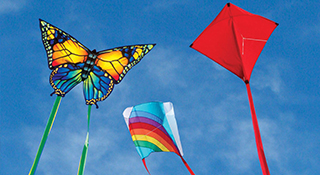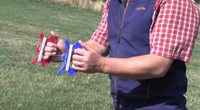FAQ – About Single Line Kites
Do I need to run with my kite to get it up in the air?
You shouldn't have to run to launch a kite. If you do, then there's probably not enough wind to fly. Running is the hardest way to launch a kite. The uncontrolled tugging on the line makes kites dive and crash. Let the wind and your reel do the work instead.
Can I use longer lines than those that come with my Ready to Fly kite?
You bet! If your kite weighs less than 5-lbs. (and almost all kites do) the FAA lets you fly as high as you want. Three hundred feet is a great line length for kids, it's enough for most small kites; 500-ft. is the most popular length for adults and for large kites; 1,000-ft. is a good length for inland areas - it lets you fly your kite in the steadier winds at altitude; 3000-ft. is for altitude freaks. Your kite will be a dot in the sky. Make sure you get a good reel!
Is kite fabric an important consideration? What are the advantages and disadvantages to ripstop sailcloth vs. polyester?
When it comes to ultra-light kites, polyester is definitely better. Most polyester fabrics used for kites are a .60 oz. versus a .75 oz. for the ripstop nylon, which means on a full size sport kite the difference in sail weight is significant. Polyester has a different finish or coating on it, which makes it less porous, so almost no air can go through the material. Polyester is also highly water resistant, unlike nylon, which will absorb water and hence make your kite heavier in damp or wet weather conditions. Polyester retains its color longer and is less prone to stretching than nylon. Polyester is also more expensive. Using ripstop nylon on high wind kites has the advantage of slowing the kite down a bit. A lot of times it depends on the design of the kite whether to use ripstop nylon or polyester. If you are a newbie, there’s no doubt that ripstop nylon is the best choice. Nylon has a good amount of stretch, which helps the fabric avoid tearing in the event of a crash.
How do I maintain control of large, hard-pulling single-line kites?
The best way to control a large kite is to anchor it to the ground. We carry several different anchor options, which run the gamut for effectiveness in firm soil to loose sand. Or, tying the line to a large immovable object is also an option.
Which kite is small enough to take on a backpacking or camping trip?
Airfoils are a good choice because they pack down to a small size (as small as 3” x 7”), are completely soft with no sticks to stow or break and are stable in a moderate wind. Stunt and power foils are compact soft kites with the pull and action of a stunt kite. Airfoils are frameless and portable (e.g. the Hot Dog fits in a 7” x 9” soft case).
What's the best kite to fly at the beach?
Almost any kite works great on a beach! Beaches are great for kites because you normally get lots of space and smooth predictable winds. Be ready for changes throughout the day, though, since winds may shift as the sun moves and temperatures over the water change. You also need to be careful about people, dogs, and other safety issues. The "best" kite depends on what you want to do. Steer a maneuverable kite around the sky? Put on a big show? Or just entertain the kids? For single-line kites, you can easily put up a larger delta, a stack of Delta Conynes, or a parafoil. Then load the line up with tubes, tails, and line art. Delta kites are stable and can fly in light to moderate wind with little effort, allowing the pilot to relax and enjoy its flight. You can go to the beach to kitesurf and power up with a big kite for some board action. Other days can be spent burning in new tricks on your stunt kites. When flying stunt kites on the beach, know that it can make folks nervous to hear the kite spinning and diving over their heads, so we don't often recommend that for most (unless you have a lot of open space to yourself).
What kite would be best for my child's birthday party?
The Frustrationless Flyer is an easy to assemble, child-friendly sled. They are made of Tyvek and are great for a pre-flight art project for kids. We suggest using acrylic paints or permanent markers to make one-of-a-kind masterpieces using this affordable kite kit. If you prefer a simpler set-up, our Color A Sled kites are perfect for parties! Also made of Tyvek, but with no assembly required, these kites include a pack of crayons for your little artists to decorate on their own. Both kits include appropriate flying line.
We are going on a trip and need a kite that is portable that we can take on an airplane. It must be packable (big suitcase), sturdy, easy to put together and durable. What would you suggest?
The best kite to travel with is a small parafoil. Into The Wind offers a variety of smaller parafoils, and soft sleds. You can choose between single-line or the maneuverable dual-line stunt kites. Most foil style kites have no sticks, so they pack easily into a corner of your suitcase. When the time comes to fly, you can stuff one in your backpack.
My family will be having our big annual barbeque on the 4th of July. This year I want to take a handful of kites so there's something for everyone to fly. What would you suggest?
Sleds and deltas! The best way to have fun at a family outing is to keep things simple. Kites that go together quickly and get in the air easily are the best type of kites to please kids of all ages. If you have enough time, you could prepare some sled kite kits in advance and start the day by having each person make their own. We sell Frustrationless Flyer Kite Kits and Color A Sleds that would fit the bill.
I’m trying to round out my kite collection, what would you recommend?
When you build a kite collection, include kites that fly at the extremes. The core of your collection can be all of the interesting stuff that flies in 5 to 20 mph winds, but have something in your bag for those "windless" and "too windy" days too. Glider kites are perfect for windless days (and even indoor flying!), while airfoils like our UltraFoils can handle winds up to 30 mph.
Which kites are good for falconry?
Falconers usually prefer kites that fly high and almost directly overhead. The best kite for falconry we have to offer is Dan Leigh's Little Bear Delta. Specially made for training falcons, the Little Bear also features a balloon keel that allows the kite to glide gently to the ground if the wind suddenly dies. This prevents the kite from incurring damage when it lands.
I'm not necessarily interested in setting a kite altitude record but I do want to fly a kite really high. Which kite would be the best choice?
Look for a fairly large kite that would provide enough lift to carry a large amount of line. It would also need to have a high angle of flight and stability in a variety of wind speeds that it might encounter at various altitudes. It is only our opinion, but we would recommend using a delta kite.
I want to fly my kite off of my boat. Which kite do you recommend? Will the speed of the boat plus the wind put too much stress on the kite? Should I use heavier line?
Flying kites from boats can be tricky. Not only the changes in apparent wind (the vector sum of the true wind speed and the speed of the boat), but the very boat itself can be a turbulence producer, making launches more difficult. So picking the right kite is important. Remember you can’t run out to the kite and re-launch it, so what happens when the kite hits the water is also something to consider. How easy is it to retrieve? On a sailboat, the sails should be down. On a power boat, try launching from the bow (into the wind) and fly from the stern. On a kayak or canoe, keep your paddle out of the way and launch by gently tossing the kite aloft. Line strength should be appropriate for the conditions. Adding boat speed to wind speed can cause a tear in the time/space continuum and yank you into another dimension – one of water. Dress appropriately. Start with a kite you won’t mind losing. If it doesn’t work the first time…buy another and try again.
How does kite stacking (ITW DCs, etc...) affect the test-weight required to fly?
Each kite you add to a stack adds that kite's pull and force to the line. For example, one (1) Rocky Mountain DC uses 100-lb. test line, so stacking two (2) Rocky Mountain DCs requires 200-lb. line, and three (3) Rocky Mountain DCs need 300-lb. test line and so on.
I bought a fighter kite. I've tried to fly it in 8 mph winds twice. I just am not sure what to do. I have the feeling that getting the bridle right is “a must.” Too much one way makes it touchy, the other way and you can't steer it. I know it has to do with tension, but can I get more information?
It sounds like your fighter is indeed very sensitive to bridle adjustments. You're on the right track, moving the bridle point forward decreases the angle of attack and therefore wind pressure. This allows the fighter to flatten and turn. Lowering the bridle point of course, decreases turn. Small adjustments are usually all that is necessary, so don't move the tow point more than a quarter of an inch at a time. Another way to make the kite adjustable in different wind conditions would be to change out the spreader for a stiffer one for higher wind conditions. To make the kite spin even easier, without losing the tracking, add a small piece of Fun Tack to the tail of your kite.
How much bow does a Rokkaku need?
As a general rule, less bow in light winds will allow the surface of the kite to catch more air, and more bow in heavy winds will spill more wind. It's also important to know that each kite will be different and you can experiment with different bow for both the top and the bottom of the kite.
I currently own a 9-ft delta single line kite. Is there a certain length of line to let out? I believe mine comes with 100-ft. of line. Is it safe to go any higher? Would I have to use stronger line?
At 100 feet, a nine-footer is just finding its wings. With 100' of line, you won't be able to get your kite up enough to catch the steadier winds that are typically several hundred feet above the ground. 500-ft. of line is a much better length, unless you're at the beach and the wind is blowing like crazy. You can expect better performance if you fly on at least a 300 foot length of line; that's only a football-field-high. Remember, at this height, you'll need to be very mindful of what's around you (i.e. no power lines, trees, streets, and so forth), but you should find that the kite flies beautifully here. As for stronger line, this depends on the winds you'll be flying in, with higher wind speeds it is always best to be safe than sorry. And, it is usually true that winds are stronger at higher altitudes.
What is the best way to fly line laundry from my lifter kite?
Connecting laundry to the flying line is easy. We use small carabiners wrapped into the line, normally three twists work just fine. When the line is slack, you can slide the "biner" anywhere you want. However, when the kite goes up and tension builds on the line, the "biner" is locked in place. Make sure each piece of line laundry has a swivel attached to it before attaching it to the line laundry connector loops or carabiners clips. It is quick, easy, and doesn't reduce line strength. You can stretch laundry out along the length of your line, or cluster several pieces - like long tubes - at a single point. Experiment! Build a collection of color-coordinated spinners, drogues and tubes that you can vary for different conditions and fields.
Why don't the wing spars on my delta extend all the way to the nose?
The stable flight of delta kites is partially due to a certain amount of wing flexibility, accomplished by allowing the two wings to flex independently of each other. If the two wing spars extended all the way to the nose, the delta frame would be too rigid, preventing the self-steering and self-correcting actions that allow deltas to ride out gusts and drift on thermals so effectively. Always push delta wing spars to the wing tips of the kite, not the nose.


